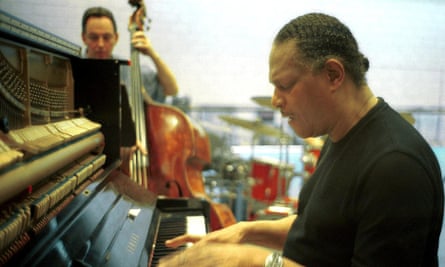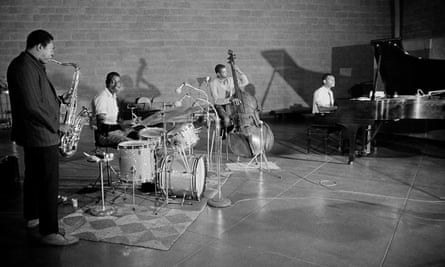Playing a supporting role to a force of nature is a tough call in any form of music – and in the maelstroms of jazz improvisation tougher still. The pianist McCoy Tyner, who has died aged 81, answered that call in 1960, when he began a partnership with an improvisational genius, the saxophonist John Coltrane.
Aged only 21, Tyner spent the next five years as a key member of a Coltrane quartet that influenced musicmaking across all genres and produced such classic jazz albums as Impressions (1963), Live at Birdland (1963) and A Love Supreme (1964).
He powered an already dynamic band with fiercely slamming, drum-like left-hand chords and harmonic ambiguities that set Coltrane’s spontaneous melodic imagination free. He could also deliver his own marathon improvised solos that were as free and unpredictable as those of his boss. Yet for all his intensity, Tyner was the most serene and genial of characters, with a chuckle that seemed to house multiple levels of meaning.

Tyner’s methods have influenced every generation of jazz pianist since the 1960s, and he stood shoulder to shoulder with such illustrious keyboard modernists as Herbie Hancock, Chick Corea, Keith Jarrett and Bill Evans. After Coltrane’s death at the age of 40 in 1967, he embarked on a distinctive career of his own as a soloist, bandleader and composer.
Born in Philadelphia, McCoy was the son of Beatrice (nee Stevenson), a beautician, and her husband, Jarvis Tyner, a church singer who worked for a firm that made medications. Aged 13 he began piano lessons, and later attended the Granoff School of Music, whose alumni included Coltrane and Dizzy Gillespie.
He led his own R&B band as a high school student and played locally with a budding star, the trumpeter Lee Morgan. His neighbours in the early 50s also included the pianist siblings Richie and Bud Powell, the latter one of the pioneers of the 40s bebop revolution.
Tyner was playing professionally by 16. Another local, the already successful saxophonist and gifted hard-bop composer Benny Golson, hired him in 1959 for the Jazztet, a new ensemble Golson would co-lead with the trumpeter Art Farmer for the next three years.
But the most significant experience in the young Tyner’s apprenticeship was his friendship with Coltrane, who had by that time already come to prominence with a career-launching stint in Miles Davis’s quintet during the mid-50s. Coltrane was an obsessive innovator whose saxophone experiments led him to compress intricate, fast-moving scales into seamless tumults of sound. He also expanded the multiphonic technique of blowing notes simultaneously to form eerie chords that were expressed with a soulful, bluesy tonality.

“Coltrane and I grew up in a period when you were supposed to try to be different, not copy someone else,” Tyner told me in 1994. “I met him at 17, used to sit on his porch with his mother – she had an old upright piano – and talk and play. He was amazing, absorbed music so quickly.”
Once Coltrane had brought Tyner into his new quartet, he remained until the classic lineup with the bassist Jimmy Garrison and the drummer Elvin Jones imploded under the pressure of Coltrane’s constant striving for a more transcendental and structureless music. Tyner left in 1965, still unreservedly respectful of his leader’s singlemindedness, but by then no longer able to locate the point of his presence in Coltrane’s changing vision.
His freelance work across the following years included creative contributions to sessions for the Blue Note label by the saxophonists Joe Henderson and Wayne Shorter, the vibraphonist Bobby Hutcherson and the guitarist Grant Green. On his own Blue Note work as a leader he began to explore a sound that was somewhere between the song-based, soul-bop sound of his 50s work, and a looser, post-Coltrane vibe – notably in his 1967 album The Real McCoy, which featured Henderson and Jones.
From 1970 onwards Tyner’s devotion to acoustic music came up against the emergence of a different kind of jazz that was driven by rock rhythms, electric instruments and synthesised textures. He eschewed electric music, despite its popularity, and for a time considered taking up taxi-driving.
By 1972, however, he had signed to the more commercially oriented Milestone label and with a band of younger newcomers began to hone an acoustic mix of postbop, chantlike Coltrane-esque hooks and Latin grooves that would bring him a big popular following. Albums from that time included the thunderous live sets Enlightenment (1973) and Atlantis (1974), which are still revered by dance-oriented audiences today.
In the 80s, with a more traditional neo-classical jazz movement emerging, Tyner often toured with all-star acoustic groups and began performing regularly in a bass-and-drums trio. He also formed a superb big band in 1988 that joined traditional jazz-orchestra ideas to the extended, repeating-hook open forms drawn from Coltrane, winning two Grammy awards as a result.
Later he led a percussion-packed Afro-Cuban all-star band in the mid-90s and revealed himself to be a compelling unaccompanied pianist with his Jazz Roots album in 2000.
In my 50-odd years of listening to jazz, Tyner’s 2002 concert at the Barbican, London, with Hutcherson, the bassist Charnett Moffett and the drummer Eric Harland, stands out for its incredible mix of headlong momentum, ritualistic insistence and elegant lyricism, along with the characteristically meditative ferocity of Tyner’s solos. That year he received one of jazz’s highest accolades when he was named a jazz master by the National Endowment for the Arts.
In 2006 Tyner recorded with a one-off quartet featuring the saxophonist Joe Lovano, and in 2008 led an unusual collaboration with four guitarists, including John Scofield and Bill Frisell. However, he increasingly withdrew from live performance in his later years.
He is survived by his wife, Aisha, his son, Nurudeen, three grandchildren, and siblings Jarvis and Gwendolyn-Yvette.

Comments (…)
Sign in or create your Guardian account to join the discussion